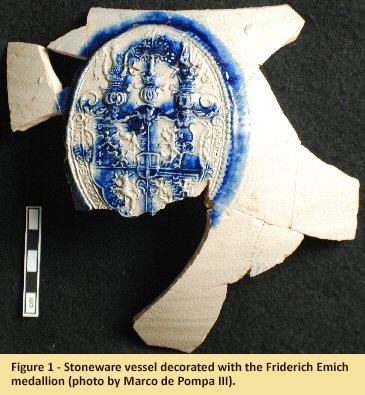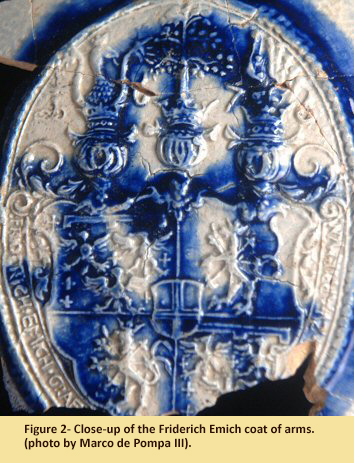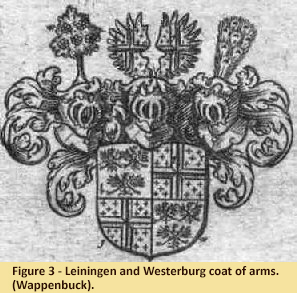Friderich Emich Medallion
November 2008
By Erin Wingfield, MAC Lab Collections Assistant
 Fragments of a large stoneware vessel with a medallion (Figure 1) were found scattered throughout a 17th century rubbish pit at the Buck Site (18KE292) along with other ceramics, pipe stems and general household
artifacts. The Buck Site is located in Kent County, Maryland about 9 miles southwest of Chestertown. The site was brought to the attention of an archaeologist, L.T. Alexander, by a private landowner who
had found several artifacts in his field. The location of the rubbish pit was later determined from examining a concentration of surface finds consisting of oyster shell and artifacts dating to the latter
half of the 17th century. The pit feature was discovered undisturbed and capped by a thick layer of oyster shell (Alexander 1984:15). The majority of artifacts unearthed were simple ceramic storage
and cooking vessels, leading to the belief that this trash pit belonged to a modest household (Alexander 1984:31). Also uncovered in this same feature were a few fragments of another medallion identical
to this one. These fragments may be from a separate vessel or there may have potentially been another medallion decorating the other side of this vessel. However, overall only a few fragments of other
stoneware ceramics were unearthed.
Fragments of a large stoneware vessel with a medallion (Figure 1) were found scattered throughout a 17th century rubbish pit at the Buck Site (18KE292) along with other ceramics, pipe stems and general household
artifacts. The Buck Site is located in Kent County, Maryland about 9 miles southwest of Chestertown. The site was brought to the attention of an archaeologist, L.T. Alexander, by a private landowner who
had found several artifacts in his field. The location of the rubbish pit was later determined from examining a concentration of surface finds consisting of oyster shell and artifacts dating to the latter
half of the 17th century. The pit feature was discovered undisturbed and capped by a thick layer of oyster shell (Alexander 1984:15). The majority of artifacts unearthed were simple ceramic storage
and cooking vessels, leading to the belief that this trash pit belonged to a modest household (Alexander 1984:31). Also uncovered in this same feature were a few fragments of another medallion identical
to this one. These fragments may be from a separate vessel or there may have potentially been another medallion decorating the other side of this vessel. However, overall only a few fragments of other
stoneware ceramics were unearthed.
This vessel is categorized as a Rhenish blue and grey stoneware. Rhenish is recognized by its grey salt glazed body and painted decoration in blue or manganese purple. On this vessel, the decoration is a
raised medallion featuring the coat of arms of Frederich Emich and is accented with swirls of blue paint. The complete vessel could have been a very large bottle or jug. It was most likely produced
in the Westerwald region of Germany. Throughout the 17th and 18th centuries, Westerwald was the largest exporter of Rhenish stoneware ceramics. Molds were used to apply decorative relief to multiple
vessels such as this one. This increased the rate of production and allowed the same mold design to be applied to several different vessel forms (Gaimster 1997:251-252).
 The Emich Medallion depicts a crest (Figure 2) of three helmets each with a crown on top. The center helmet is topped with a tree and two other unidentified images are located over the right and left
helmets. The shield is quartered with a smaller shield in the center. The small, central shield contains a cross design. In the main shield, the top left quadrant features three displayed eagles. The top right
quadrant contains a lion rampant with two tails and a crown on its head. In the bottom half of the shield, the two quadrants are exactly the same but their placement is reversed, with the lion on the left
and the eagles on the right. The completed inscription under the shield would read, "FRIDERICH EMICH GRAF ZU LEININGEN UND TAXBURG HERR ZU APPIRMUN". This inscription states that Friderich Emich
was the Count of Leiningen and Taxburg or Dagsburg. Several bottles similar to this vessel were produced for the wedding of Count Emich’s son Emich XIII on February 24, 1676. The inscription on these vessels
is exactly the same but the wedding bottles include the date 1676 at the end (Alexander 1984:25).
The Emich Medallion depicts a crest (Figure 2) of three helmets each with a crown on top. The center helmet is topped with a tree and two other unidentified images are located over the right and left
helmets. The shield is quartered with a smaller shield in the center. The small, central shield contains a cross design. In the main shield, the top left quadrant features three displayed eagles. The top right
quadrant contains a lion rampant with two tails and a crown on its head. In the bottom half of the shield, the two quadrants are exactly the same but their placement is reversed, with the lion on the left
and the eagles on the right. The completed inscription under the shield would read, "FRIDERICH EMICH GRAF ZU LEININGEN UND TAXBURG HERR ZU APPIRMUN". This inscription states that Friderich Emich
was the Count of Leiningen and Taxburg or Dagsburg. Several bottles similar to this vessel were produced for the wedding of Count Emich’s son Emich XIII on February 24, 1676. The inscription on these vessels
is exactly the same but the wedding bottles include the date 1676 at the end (Alexander 1984:25).
Political portraits and heraldry on ceramic vessels were popular throughout the 16th and 17th centuries. Potters would favor producing vessels with arms of their benefactors and regional nobility (Gaimster
1997:153). However, potteries would also produce vessels with political images from countries other than their own. This would often lead to incorrect coats of arms or images that misrepresented foreign
nobles (Gaimster 1997:160). These politically designed vessels were shipped internationally to spread knowledge of a particular noble's name, family and territory. These vessels could also be used as
forms of political propaganda combining images of values such as faith and hope with the portrait of a specific noble. Slogans could be added supporting political unity under a certain ruler or showcasing
a noble’s blood ties to a specific nationality or important individual. (Gaimster 1997:154). Vessels featuring armorials were exported heavily to other locations in Europe and the colonies. Archaeologists have found examples in England, Scandinavia and North America (Gaimster 1997:156).
 German coats of arms were typically used to distinguish members of the nobility. Specific elements such as the barred helmets and crowns included in the crest on the Emich medallion were restricted for
use only by the nobility in the 17th century. Coats of arms may contain the same family shield with different crests above it to recognize individuals in a family. Others may combine elements within
their shields to differentiate between branches of one family (Pine 1970:191). The Leiningen and Westerburg coat of arms (Figure 3) includes in its shield the three eagles for Leiningen and the cross
for Westerburg. It is also possible that this cross may be the same one that is depicted in the small shield on the Emich medallion.
German coats of arms were typically used to distinguish members of the nobility. Specific elements such as the barred helmets and crowns included in the crest on the Emich medallion were restricted for
use only by the nobility in the 17th century. Coats of arms may contain the same family shield with different crests above it to recognize individuals in a family. Others may combine elements within
their shields to differentiate between branches of one family (Pine 1970:191). The Leiningen and Westerburg coat of arms (Figure 3) includes in its shield the three eagles for Leiningen and the cross
for Westerburg. It is also possible that this cross may be the same one that is depicted in the small shield on the Emich medallion.
There has been little conclusive research on the family or structure associated with the Buck Site rubbish pit and consequently the owners of this vessel. When the pit was covered, there were only a few
dwellings in use on the property. From the artifacts uncovered in this feature, it is believed that these individuals were slaves or indentured servants (Alexander 1984:16). However, the exact name
and origin of the tenants is still unknown. It is possible this vessel was brought over by a German immigrant or was received as a gift or even purchased locally. As with many other interesting
archaeological finds, it is unlikely we will ever really know who owned this vessel and how it was regarded before it was thrown away.
| References |
|
| Alexander, L. T. |
| 1984 |
North Devon Pottery and Other Finds C.A.D. 1660-1700. The Bulletin and Journal of Archaeology for New York State 88:15-32. |
|
| Ga |
| imster, David |
| 1997 |
German Stoneware 1200-1900: Archaeology and Cultural History. British Museum Press, London. |
|
| Pine, L. G. |
| 1970 |
International Heraldry. Charles E. Tuttle Co., Vermont. |
|
| Wa |
| ppenbuck |
|
Electronic Document, http://www.wappenbuch.de/images/wappen_w016_Teil_1.jpg - accessed October 21, 2008. |
|